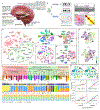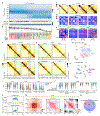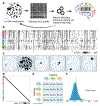Single-cell DNA methylation and 3D genome architecture in the human brain
- PMID: 37824674
- PMCID: PMC10572106
- DOI: 10.1126/science.adf5357
Single-cell DNA methylation and 3D genome architecture in the human brain
Abstract
Delineating the gene-regulatory programs underlying complex cell types is fundamental for understanding brain function in health and disease. Here, we comprehensively examined human brain cell epigenomes by probing DNA methylation and chromatin conformation at single-cell resolution in 517 thousand cells (399 thousand neurons and 118 thousand non-neurons) from 46 regions of three adult male brains. We identified 188 cell types and characterized their molecular signatures. Integrative analyses revealed concordant changes in DNA methylation, chromatin accessibility, chromatin organization, and gene expression across cell types, cortical areas, and basal ganglia structures. We further developed single-cell methylation barcodes that reliably predict brain cell types using the methylation status of select genomic sites. This multimodal epigenomic brain cell atlas provides new insights into the complexity of cell-type-specific gene regulation in adult human brains.
Conflict of interest statement
Figures






References
-
- Liu H, Zhou J, Tian W, Luo C, Bartlett A, Aldridge A, Lucero J, Osteen JK, Nery JR, Chen H, Rivkin A, Castanon RG, Clock B, Li YE, Hou X, Poirion OB, Preissl S, Pinto-Duarte A, O’Connor C, Boggeman L, Fitzpatrick C, Nunn M, Mukamel EA, Zhang Z, Callaway EM, Ren B, Dixon JR, Behrens MM, Ecker JR, DNA methylation atlas of the mouse brain at single-cell resolution. Nature. 598, 120–128 (2021). - PMC - PubMed
-
- Li YE, Preissl S, Hou X, Zhang Z, Zhang K, Qiu Y, Poirion OB, Li B, Chiou J, Liu H, Pinto-Duarte A, Kubo N, Yang X, Fang R, Wang X, Han JY, Lucero J, Yan Y, Miller M, Kuan S, Gorkin D, Gaulton KJ, Shen Y, Nunn M, Mukamel EA, Behrens MM, Ecker JR, Ren B, An atlas of gene regulatory elements in adult mouse cerebrum. Nature. 598, 129–136 (2021). - PMC - PubMed
-
- He Y, Hariharan M, Gorkin DU, Dickel DE, Luo C, Castanon RG, Nery JR, Lee AY, Zhao Y, Huang H, Williams BA, Trout D, Amrhein H, Fang R, Chen H, Li B, Visel A, Pennacchio LA, Ren B, Ecker JR, Spatiotemporal DNA methylome dynamics of the developing mouse fetus. Nature. 583, 752–759 (2020). - PMC - PubMed

